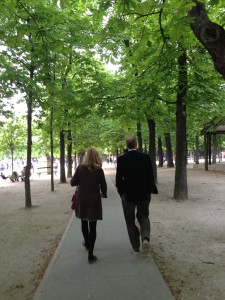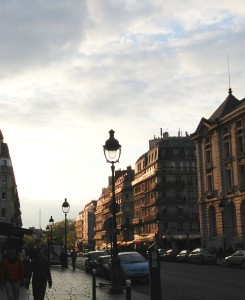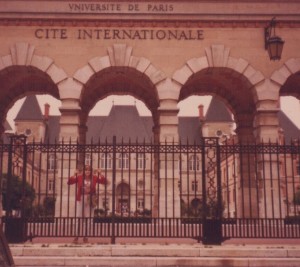
I had not been back to the Cité Universitaire since I lived there that summer thirty-two years ago. (See That French Connection, April 2014.) I hadn’t expected to return on this trip. I thought it would hold minimal interest for my husband and daughter. But on our first day in Paris, a Saturday during spring break, we found ourselves engulfed in crowds. The area in front of Notre-Dame Cathedral was a roiling sea of humanity. The line for the Sainte-Chapelle stretched for blocks. We expected Palm Sunday at all the expected sites to be equally busy. This factor may have persuaded H and D that we should visit the Cité, located in an unfashionable area at the bottom of the Paris map. Tourists would certainly not be flocking there.
I had remembered the Cité as being far removed from the city center. I was surprised to see that it was only three stops from Luxembourg on the RER. I was also surprised to see the complex looking almost exactly as I recalled it, but spruced up and considerably less seedy. It wasn’t exactly run-down in 1982. Perhaps indifferently maintained is a good way to describe it. The grounds were wild and weedy, closer to messy than pristine. Litter was common. This past April, the Cité was looking comparatively fresh, fit and clean. The plantings were lush and well-tended. The buildings were grander and more imposing than I had remembered. And there were fewer shady characters skulking about.

My little room was perfectly adequate, and I loved my balcony that looked out onto the big evergreen tree, the then-scruffy garden, and the Mexico building. On the top floor were much sought-after artists’ lofts, with high ceilings and skylights.

In the photo above, the open balcony door at the right suggests that the current resident was in my old room. The same red-orange draperies adorn the windows. The tall tree still flourishes in the courtyard.

Although the institutional décor left something to be desired, I enjoyed that humble, well-worn room. In addition to the vinyl-covered armchair, there was a decent bed, desk, and a reading lamp with a shade covered in peeling contact paper. The open balcony doors provided all the air conditioning needed. Not a single mosquito, gnat or fly ever flew in. Toilet cubicles and showers were down the hall, of course. There was no adjusting the water pressure or its temperature in the shower. You pushed a button, which triggered a quick burst of water that lasted about three minutes. Luckily, the button could be pressed multiple times, or I never could have rinsed the shampoo from my hair. The atmosphere was classic Paris student.
The sight of those bare shelves in that room reminds me of how lightly and simply I traveled that summer. Some aspirin, soap, toothbrush, a little make-up, some paper, pens and pencils, a book or too. My address book and airmail envelopes for letters to the States. I did bring a travel iron, at my mother’s insistence, which I don’t think I ever used. Its adapter was nearly as large as the iron. No cell phone, iPod, iPad, no laptop. From the looks of the trash bin at my feet, I had recently polished off two boxes of French crackers. My friends and I snacked on packaged melba toast-like crisps and La Vache qui Rit cheese. For further between-meal sustenance, I had brought a large supply of grape Tangy Taffy from home.
Thirty-two years later, as I stood there in the garden behind the building, my husband and daughter by my side, looking up at the open door to my old room, the memories swirled around me. Some were vivid, others were just out of reach, like dreams upon waking. The experience was unsettling. I understood then why some prefer never to return to such places. As for me, though, I’ll go back. Those chances to glimpse the present through the eyes of the past, and vice-versa–they add a richness to life that I want to savor. Even if there may be bitter along with the sweet.

















































